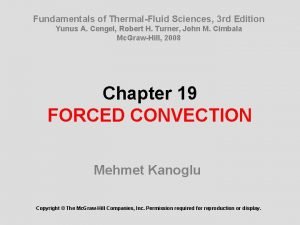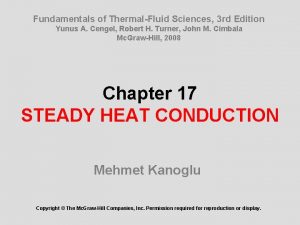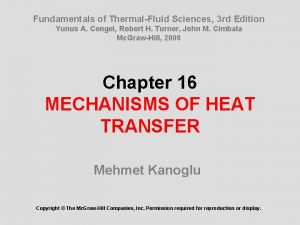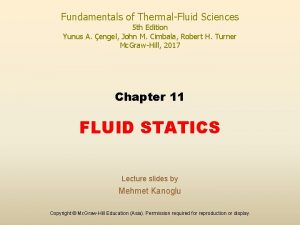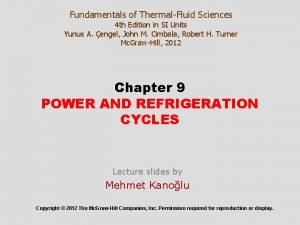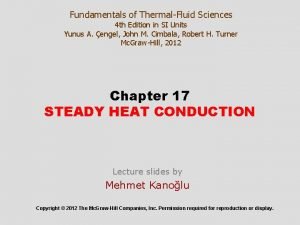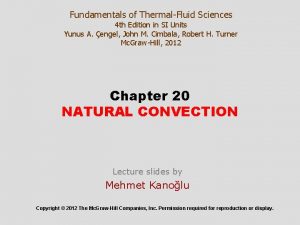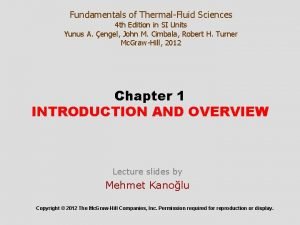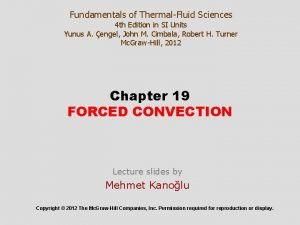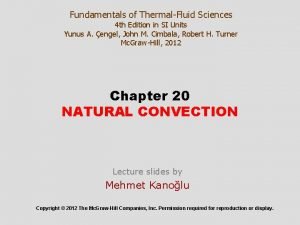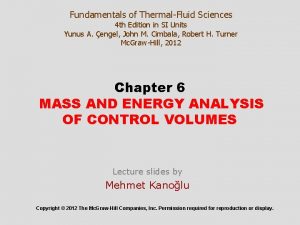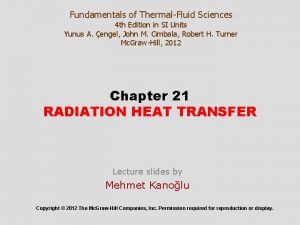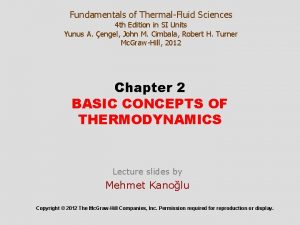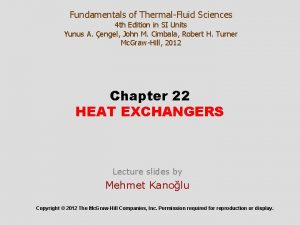Fundamentals of ThermalFluid Sciences 3 rd Edition Yunus



















- Slides: 19

Fundamentals of Thermal-Fluid Sciences, 3 rd Edition Yunus A. Cengel, Robert H. Turner, John M. Cimbala Mc. Graw-Hill, 2008 Chapter 16 MECHANISMS OF HEAT TRANSFER Mehmet Kanoglu Copyright © The Mc. Graw-Hill Companies, Inc. Permission required for reproduction or display.

Objectives • Understand the basic mechanisms of heat transfer, which are conduction, convection, and radiation, and Fourier's law of heat conduction, Newton's law of cooling, and the Stefan– Boltzmann law of radiation • Identify the mechanisms of heat transfer that occur simultaneously in practice • Develop an awareness of the cost associated with heat losses • Solve various heat transfer problems encountered in practice 2

INTRODUCTION • Heat: The form of energy that can be transferred from one system to another as a result of temperature difference. • Thermodynamics concerned with the amount of heat transfer as a system undergoes a process from one equilibrium state to another. • Heat Transfer deals with the determination of the rates of such energy transfers as well as variation of temperature. • The transfer of energy as heat is always from the highertemperature medium to the lower-temperature one. • Heat transfer stops when the two mediums reach the same temperature. • Heat can be transferred in three different modes: conduction, convection, radiation 3

CONDUCTION Conduction: The transfer of energy from the more energetic particles of a substance to the adjacent less energetic ones as a result of interactions between the particles. In gases and liquids, conduction is due to the collisions and diffusion of the molecules during their random motion. In solids, it is due to the combination of vibrations of the molecules in a lattice and the energy transport by free electrons. The rate of heat conduction through a plane layer is proportional to the temperature difference across the layer and the heat transfer area, but is inversely proportional to the thickness of the layer. Heat conduction through a large plane wall of thickness x and area A. 4

When x → 0 Fourier’s law of heat conduction Thermal conductivity, k: A measure of the ability of a material to conduct heat. Temperature gradient d. T/dx: The slope of the temperature curve on a T-x diagram. Heat is conducted in the direction of decreasing temperature, and the temperature gradient becomes negative when temperature decreases with increasing x. The negative sign in the equation ensures that heat transfer in the positive x direction is a positive quantity. In heat conduction analysis, A represents the area normal to the direction of heat transfer. The rate of heat conduction through a solid is directly proportional to its thermal 5 conductivity.

Thermal Conductivity Thermal conductivity: The rate of heat transfer through a unit thickness of the material per unit area per unit temperature difference. The thermal conductivity of a material is a measure of the ability of the material to conduct heat. A high value for thermal conductivity indicates A simple experimental setup that the material is a to determine thermal good heat conductor, and a low value indicates conductivity of a material. that the material is a poor heat conductor or insulator. 6

The range of thermal conductivity of various materials at room temperature. 7

The thermal conductivities of gases such as air vary by a factor of 104 from those of pure metals such as copper. Pure crystals and metals have the highest thermal conductivities, and gases and insulating materials the lowest. The mechanisms of heat conduction in different phases of a substance. 8

The variation of thermal conductivity of various solids, liquids, and gases with temperature. 9

Thermal Diffusivity cp Specific heat, J/kg · °C: Heat capacity per unit mass cp Heat capacity, J/m 3 · °C: Heat capacity per unit volume Thermal diffusivity, m 2/s: Represents how fast heat diffuses through a material A material that has a high thermal conductivity or a low heat capacity will obviously have a large thermal diffusivity. The larger thermal diffusivity, the faster the propagation of heat into the medium. A small value of thermal diffusivity means that heat is mostly absorbed by the material and a small amount of heat is conducted further. 10

CONVECTION Convection: The mode of energy transfer between a solid surface and the adjacent liquid or gas that is in motion, and it involves the combined effects of conduction and fluid motion. The faster the fluid motion, the greater the convection heat transfer. In the absence of any bulk fluid motion, heat transfer between a solid surface and the adjacent fluid is by pure conduction. Heat transfer from a hot surface to air by convection. 11

Forced convection: If the fluid is forced to flow over the surface by external means such as a fan, pump, or the wind. Natural (or free) convection: If the fluid motion is caused by buoyancy forces that are induced by density differences due to the variation of temperature in the fluid. The cooling of a boiled egg by forced and natural convection. Heat transfer processes that involve change of phase of a fluid are also considered to be convection because of the fluid motion induced during the process, such as the rise of the vapor bubbles during boiling or the fall of the liquid droplets during condensation. 12

Newton’s law of cooling h As Ts T convection heat transfer coefficient, W/m 2 · °C the surface area through which convection heat transfer takes place the surface temperature the temperature of the fluid sufficiently far from the surface. The convection heat transfer coefficient h is not a property of the fluid. It is an experimentally determined parameter whose value depends on all the variables influencing convection such as - the surface geometry - the nature of fluid motion - the properties of the fluid - the bulk fluid velocity 13

RADIATION • Radiation: The energy emitted by matter in the form of electromagnetic waves (or photons) as a result of the changes in the electronic configurations of the atoms or molecules. • Unlike conduction and convection, the transfer of heat by radiation does not require the presence of an intervening medium. • In fact, heat transfer by radiation is fastest (at the speed of light) and it suffers no attenuation in a vacuum. This is how the energy of the sun reaches the earth. • In heat transfer studies we are interested in thermal radiation, which is the form of radiation emitted by bodies because of their temperature. • All bodies at a temperature above absolute zero emit thermal radiation. • Radiation is a volumetric phenomenon, and all solids, liquids, and gases emit, absorb, or transmit radiation to varying degrees. • However, radiation is usually considered to be a surface phenomenon for solids. 14

Stefan–Boltzmann law = 5. 670 10 8 W/m 2 · K 4 Stefan–Boltzmann constant Blackbody: The idealized surface that emits radiation at the maximum rate. Radiation emitted by real surfaces Emissivity : A measure of how closely a surface approximates a blackbody for which = 1 of the surface. 0 1. Blackbody radiation represents the maximum amount of radiation that can be emitted from a surface at a specified temperature. 15

Absorptivity : The fraction of the radiation energy incident on a surface that is absorbed by the surface. 0 1 A blackbody absorbs the entire radiation incident on it ( = 1). Kirchhoff’s law: The emissivity and the absorptivity of a surface at a given temperature and wavelength are equal. The absorption of radiation incident on an opaque surface of absorptivity. 16

Net radiation heat transfer: The difference between the rates of radiation emitted by the surface and the radiation absorbed. Radiation heat transfer between a surface and the surfaces surrounding it. The determination of the net rate of heat transfer by radiation between two surfaces is a complicated matter since it depends on • the properties of the surfaces • their orientation relative to each other • the interaction of the medium between the surfaces with radiation When radiation and convection occur Radiation is usually significant relative to conduction or natural convection, but negligible relative to forced convection. simultaneously between a surface and a gas Combined heat transfer coefficient hcombined Includes the effects of both convection and radiation 17

SIMULTANEOUS HEAT TRANSFER MECHANISMS Heat transfer is only by conduction in opaque solids, but by conduction and radiation in semitransparent solids. A solid may involve conduction and radiation but not convection. A solid may involve convection and/or radiation on its surfaces exposed to a fluid or other surfaces. Heat transfer is by conduction and possibly by radiation in a still fluid (no bulk fluid motion) and by convection and radiation in a flowing fluid. In the absence of radiation, heat transfer through a fluid is either by conduction or convection, depending on the presence of any bulk fluid motion. Convection = Conduction + Fluid motion Heat transfer through a vacuum is by radiation. Most gases between two solid surfaces do not interfere with radiation. Liquids are usually strong absorbers of radiation. Although there are three mechanisms of heat transfer, a medium may involve 18 only two of them simultaneously.

Summary • Conduction ü Fourier’s law of heat conduction ü Thermal Conductivity ü Thermal Diffusivity • Convection ü Newton’s law of cooling • Radiation ü Stefan–Boltzmann law • Simultaneous Heat Transfer Mechanisms 19
 Human sciences
Human sciences Computer security fundamentals 4th edition
Computer security fundamentals 4th edition Fundamentals of corporate finance canadian edition
Fundamentals of corporate finance canadian edition Machining fundamentals 10th edition
Machining fundamentals 10th edition Fundamentals of information systems 9th edition
Fundamentals of information systems 9th edition Digital fundamentals 10th edition
Digital fundamentals 10th edition Fundamentals of information systems 9th edition
Fundamentals of information systems 9th edition Management fundamentals 8th edition
Management fundamentals 8th edition Fundamentals of corporate finance fifth edition
Fundamentals of corporate finance fifth edition Fundamentals of organizational communication
Fundamentals of organizational communication Fundamentals of heat and mass transfer 4th edition
Fundamentals of heat and mass transfer 4th edition Digital fundamentals floyd ppt
Digital fundamentals floyd ppt No slip condition
No slip condition Fundamentals of corporate finance 6th edition
Fundamentals of corporate finance 6th edition Fundamentals of information systems
Fundamentals of information systems Fundamentals of organizational communication 9th edition
Fundamentals of organizational communication 9th edition The fundamentals of political science research 2nd edition
The fundamentals of political science research 2nd edition Dc/ac fundamentals 1st edition
Dc/ac fundamentals 1st edition Digital fundamentals floyd 10th edition
Digital fundamentals floyd 10th edition Abnormal psychology comer 9th edition
Abnormal psychology comer 9th edition





















